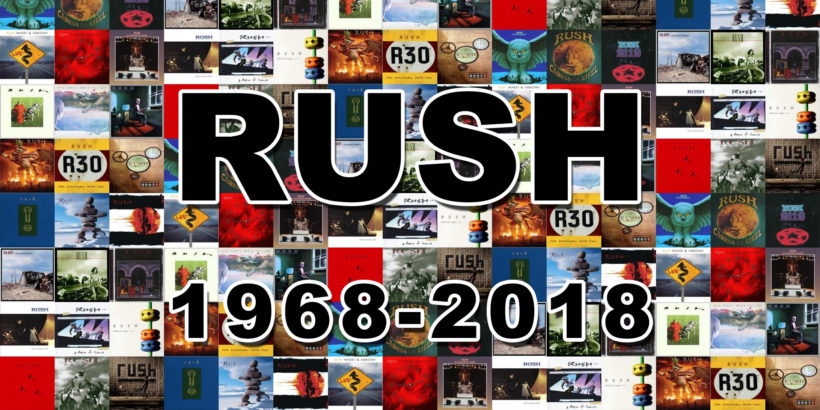
The Top 10 Greatest Rush Songs
It may have taken much longer than it should have; however, legendary progressive rock band Rush finally received the recognition they deserved. After years of frustration by longtime fans of the Canadian rock trio, in 2013 they were recognized as one of the greatest bands in music history by being inducted into the Rock and Roll Hall of Fame. Having been nominated seven times for a Grammy Award, Rush never received that honor, despite charting some of the biggest hits in rock. The band’s classic lineup includes original and longest-tenured members Alex Lifeson, Geddy Lee and Neil Peart. Rush has seen several lineup changes since first forming in 1968; the band has gone through some difficult times including creative differences. When Rush concluded its final R40 Live Tour, the band decided to retire in 2018. During their over four-decade run, the progressive-rockers recorded 19 studio albums and charted several major hits and found its greatest success from the Moving Pictures album released in 1981.
Here are our top 10 favorite songs by Rush:
10 – “Subdivisions”
From: Signals (1982)
The follow-up album to the highly regarded and most successful Rush album Moving Pictures, Signals continued the use of synthesizers and other electronic elements, resulting in a solid album. With Peart writing all the lyrics on the album except for one song (“Chemistry”), the trio consisting of Lee, Peart and Lifeson produced a platinum-selling album that reached top ten on Billboard’s Top 200. As the album’s first track, “Subdivisions” reached mainstream rock fans and charted at No. 8 on the Album Rock Tracks chart.
9 – “Freewill”
From: Permanent Waves (1980)
This radio favorite hit was the second song on the Permanent Waves album. The song clearly showcases Lifeson’s masterful guitar skills along with the rapid-fire drumbeats of Peart. “Freewill” was initially overshadowed by the album’s biggest hit, “Spirit of Radio.” The song showcases Rush’s well-balanced collective offering by all three members.
8 – “Time Stand Still”
From: Hold Your Fire (1987)
Released in 1987, Hold Your Fire is the twelfth studio album, and it had been highly criticized for the overuse of synthesizers and pop-sounding music. This song introduced a smooth sound without the overly complex track included the use of additional musicians, including ‘Til Tuesday’s Aimee Mann and Andy Richards. “Time Stand Still” was a relatively successful song that peaked at No. 3 on the U.S. mainstream rock charts.
7 – “Closer to the Heart”
From: A Farewell to Kings (1977)
This acoustic-centered song was one of Rush’s earliest hits from their fifth studio album, A Farewell to Kings. The album consisted of two extremes, containing very short and very long songs, with “Closer to the Heart” clocking at 2:54. The song peaked at 76 on Billboard’s Hot 100 and helped the band gain notoriety with American rock fans. Although considered by many a pop song, “Closer to the Heart” became a popular radio hit during that time.
5 – ‘2112: Overture /The Temples of Syrinx’
From: 2112 (1976)
One of Rush’s earliest and most recognized works, released in 1976 and considered highly underrated by mainstream rock fans, Rush’s most loyal fans have argued for years that this was the band’s greatest album ever produced. The fourth studio album from the Canadian trio used a mix of stereophonic styles to produce a classic hard rock sound without the overuse of synthesizers that were a huge part of their later works. The first quarter of the title track is an instrument-only medley that eventually works into Lee’s legendary voice. With Peart now a regular member, his drums are clearly apparent in every one of the seven tracks, including the 20:34 title track “2112: Overture /The Temples of Syrinx.”
4 – “Fly by Night”
From: Fly by Night (1975)
This is the song that put Rush into the hearts of rock fans in 1975. This song shows Lee’s tenor-like vocal range along with Peart’s expert drumming that led to it becoming one of the band’s early hits. It was Peart’s first appearance with the band and included more of a classic rock sound without the synthesizers that weren’t heavily used until 1982’s Signals album.
3 – “Limelight”
From: ‘Moving Pictures’ (1981)
Arguably the band’s best album, Moving Pictures produced several top hits that put them into steady radio rotation in the summer of 1981 and into 1982. Reaching No. 55 on the U.S. Billboard Hot 100, “Limelight” is a clean, easy-to-follow drum-rich song that highlights Neil Peart’s expertly clean rolling drumming skills, setting him a category of his own as one of the best of all time.
2 – “The Spirit of Radio”
From: Permanent Waves (1980)
This song didn’t crack the top 50 singles chart that year, peaking at #51 on the Billboard Hot 100 chart. “The Spirit of Radio” is a song shows the vocal range of Lee along with an instrumentalrich sound that also incorporated two new and unique sounds on a rock record of that time. The final minute of “Spirit of the Radio” included both a reggae influence and Chubby Checker rapid piano style while also keeping with the band’s recognizable rock sound. The intermixing of instrumentals creates a non-stop explosion of sounds that peaks and leverages, reaching a reverse crescendo unique to Rush songs.
1 – “Tom Sawyer”
From: Moving Pictures (1981)
The opening track to Rush’s most commercially successful album, “Moving Pictures,” this song propelled Rush straight to the top and peaked at No. 3 on the albums charts. A synthesizer-rich song combined with heavy guitar riffs made ‘Tom Sawyer’ one of the biggest rock hits of all time. In 1981, it reached No. 8 on the Billboard Top Tracks chart. The song’s lyrics were written by Peart, Lee and Lifeson and also included the help of lyricist Pye Dubois, who also penned several other Rush songs.
